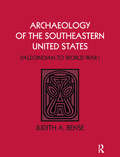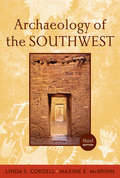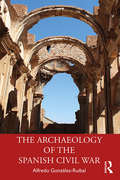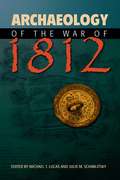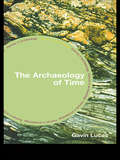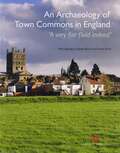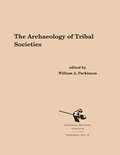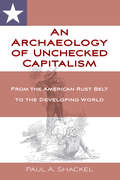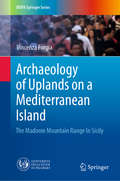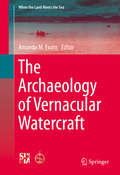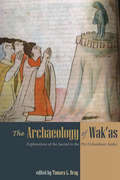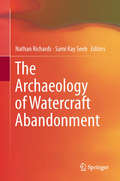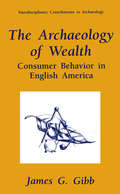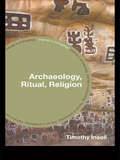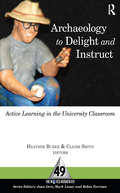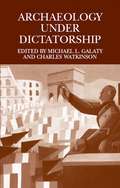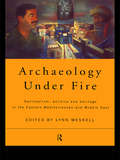- Table View
- List View
Archaeology of the Southeastern United States: Paleoindian to World War I
by Judith A BenseA chronological summary of major stages in Southeastern United States' development, this unique textbook overviews the region's archaeology from 20,000 years ago to World War I. Early chapters review the history and development of archaeology as a discipline. The following chapters, organized in chronological order, highlight the archaeological characteristics of each featured period. The book's final chapters discuss new directions in Southeastern archaeology, including trends in teaching, research, the business of archaeology, and the public's growing interest. This versatile text perfectly suits undergraduates or anyone requiring a hands-on guide for self-exploration of the fascinating region. This is the first-of-its kind book to summarize Southeastern archaeology. It includes both prehistoric and historic archaeology. Its easy-to-read format is filled with valuable research information. Each chapter is chronologically organized and fully referenced. It has broad audience appeal.
Archaeology of the Southeastern United States: Paleoindian to World War I
by Judith A BenseA chronological summary of major stages in Southeastern United States' development, this unique textbook overviews the region's archaeology from 20,000 years ago to World War I. Early chapters review the history and development of archaeology as a discipline. The following chapters, organized in chronological order, highlight the archaeological characteristics of each featured period. The book's final chapters discuss new directions in Southeastern archaeology, including trends in teaching, research, the business of archaeology, and the public's growing interest. This versatile text perfectly suits undergraduates or anyone requiring a hands-on guide for self-exploration of the fascinating region. This is the first-of-its kind book to summarize Southeastern archaeology. It includes both prehistoric and historic archaeology. Its easy-to-read format is filled with valuable research information. Each chapter is chronologically organized and fully referenced. It has broad audience appeal.
Archaeology of the Southwest (Routledge World Archaeology)
by Linda S Cordell Maxine McBrinnThe long-awaited third edition of this well-known textbook continues to be the go-to text and reference for anyone interested in Southwest archaeology. It provides a comprehensive summary of the major themes and topics central to modern interpretation and practice. More concise, accessible, and student-friendly, the Third Edition offers students the latest in current research, debates, and topical syntheses as well as increased coverage of Paleoindian and Archaic periods and the Casas Grandes phenomenon. It remains the perfect text for courses on Southwest archaeology at the advanced undergraduate and graduate levels and is an ideal resource book for the Southwest researchers’ bookshelf and for interested general readers.
Archaeology of the Southwest: Contact, Commerce, And Change In The U. S. Southwest And Northwestern Mexico (Proceedings Of Sw Symposium Ser.)
by Linda S Cordell Maxine McBrinnThe long-awaited third edition of this well-known textbook continues to be the go-to text and reference for anyone interested in Southwest archaeology. It provides a comprehensive summary of the major themes and topics central to modern interpretation and practice. More concise, accessible, and student-friendly, the Third Edition offers students the latest in current research, debates, and topical syntheses as well as increased coverage of Paleoindian and Archaic periods and the Casas Grandes phenomenon. It remains the perfect text for courses on Southwest archaeology at the advanced undergraduate and graduate levels and is an ideal resource book for the Southwest researchers’ bookshelf and for interested general readers.
The Archaeology of the Spanish Civil War
by Alfredo González-RuibalThe Archaeology of the Spanish Civil War offers the first comprehensive account of the Spanish Civil War from an archaeological perspective, providing an alternative narrative on one of the most important conflicts of the twentieth century, widely seen as a prelude to the Second World War.Between 1936 and 1939, totalitarianism and democracy, fascism and revolution clashed in Spain, while the latest military technologies were being tested, including strategic bombing and combined arms warfare, and violence against civilians became widespread. Archaeology, however, complicates the picture as it brings forgotten actors into play: obsolete weapons, vernacular architecture, ancient structures (from Iron Age hillforts to sheepfolds), peasant traditions, and makeshift arms. By looking at these things, another story of the war unfolds, one that pays more attention to intimate experiences and anonymous individuals. Archaeology also helps to clarify battles, which were often chaotic and only partially documented, and to understand better the patterns of political violence, whose effects were literally buried for over 70 years. The narrative starts with the coup against the Second Spanish Republic on 18 July 1936, follows the massacres and battles that marked the path of the war, and ends in the early 1950s, when the last forced labor camps were closed and the anti-Francoist guerrillas suppressed.The book draws on 20 years of research to bring together perspectives from battlefield archaeology, archaeologies of internment, and forensics. It will be of interest to anybody interested in historical and contemporary archaeology, human rights violations, modern military history, and negative heritage.
The Archaeology of the Spanish Civil War (PDF)
by Alfredo González-RuibalThe Archaeology of the Spanish Civil War offers the first comprehensive account of the Spanish Civil War from an archaeological perspective, providing an alternative narrative on one of the most important conflicts of the twentieth century, widely seen as a prelude to the Second World War.Between 1936 and 1939, totalitarianism and democracy, fascism and revolution clashed in Spain, while the latest military technologies were being tested, including strategic bombing and combined arms warfare, and violence against civilians became widespread. Archaeology, however, complicates the picture as it brings forgotten actors into play: obsolete weapons, vernacular architecture, ancient structures (from Iron Age hillforts to sheepfolds), peasant traditions, and makeshift arms. By looking at these things, another story of the war unfolds, one that pays more attention to intimate experiences and anonymous individuals. Archaeology also helps to clarify battles, which were often chaotic and only partially documented, and to understand better the patterns of political violence, whose effects were literally buried for over 70 years. The narrative starts with the coup against the Second Spanish Republic on 18 July 1936, follows the massacres and battles that marked the path of the war, and ends in the early 1950s, when the last forced labor camps were closed and the anti-Francoist guerrillas suppressed.The book draws on 20 years of research to bring together perspectives from battlefield archaeology, archaeologies of internment, and forensics. It will be of interest to anybody interested in historical and contemporary archaeology, human rights violations, modern military history, and negative heritage.
Archaeology of the War of 1812
by Michael T. Lucas Julie M. SchablitskyThis is the first summary of how archaeology has contributed to our understanding of the War of 1812. The contributors of original papers discuss recent excavations and field surveys that present an archaeological perspective that enriches,—and often conflicts with, received historical narratives. The studies cover fortifications, encampments, landscapes, shipwrecks, and battles in the midwestern, southern, mid-atlantic, and northeastern regions of the United States and in Canada. In addition to archaeologists, this volume will appeal to military history specialists and other historians.
Archaeology of the War of 1812
by Michael T. Lucas Julie M. SchablitskyThis is the first summary of how archaeology has contributed to our understanding of the War of 1812. The contributors of original papers discuss recent excavations and field surveys that present an archaeological perspective that enriches,—and often conflicts with, received historical narratives. The studies cover fortifications, encampments, landscapes, shipwrecks, and battles in the midwestern, southern, mid-atlantic, and northeastern regions of the United States and in Canada. In addition to archaeologists, this volume will appeal to military history specialists and other historians.
The Archaeology of Time
by Gavin LucasIt might seem obvious that time lies at the heart of archaeology, since archaeology is about the past. However, the issue of time is complicated and often problematic, and although we take it very much for granted, our understanding of time affects the way we do archaeology.This book is an introduction not just to the issues of chronology and dating, but time as a theoretical concept and how this is understood and employed in contemporary archaeology. It provides a full discussion of chronology and change, time and the nature of the archaeological record, and the perception of time and history in past societies. Drawing on a wide range of archaeological examples from a variety of regions and periods, The Archaeology of Time provides students with a crucial source book on one of the key themes of archaeology.
The Archaeology of Time
by Gavin LucasIt might seem obvious that time lies at the heart of archaeology, since archaeology is about the past. However, the issue of time is complicated and often problematic, and although we take it very much for granted, our understanding of time affects the way we do archaeology.This book is an introduction not just to the issues of chronology and dating, but time as a theoretical concept and how this is understood and employed in contemporary archaeology. It provides a full discussion of chronology and change, time and the nature of the archaeological record, and the perception of time and history in past societies. Drawing on a wide range of archaeological examples from a variety of regions and periods, The Archaeology of Time provides students with a crucial source book on one of the key themes of archaeology.
An Archaeology of Town Commons in England: 'A very fair field indeed' (English Heritage)
by Mark Bowden Graham Brown Nicky SmithThis is the first published overview of the archaeology of urban common land. By recognising that urban common land represents a valid historical entity, this book contributes towards successful informed conservation. It contains a variety of interesting and illuminating illustrations, including contemporary and archive photographs. Historically, towns in England were provided with common lands for grazing the draft animals of townspeople engaged in trade and for the pasturing of farm animals in an economy where the rural and the urban were inextricably mixed. The commons yielded wood, minerals, fruits and wild animals to the town's inhabitants and also developed as places of recreation and entertainment, as extensions of domestic and industrial space, and as an arena for military, religious and political activities. However, town commons have been largely disregarded by historians and archaeologists; the few remaining urban commons are under threat and are not adequately protected, despite recognition of their wildlife and recreational value. In 2002, English Heritage embarked upon a project to study town commons in England, to match its existing initiatives in other aspects of the urban scene. The aim was to investigate, through a representative sample, the archaeological content and Historic Environment value of urban commons in England and to prompt appropriate conservation strategies for them. The resulting book is the first overview of the archaeology of town commons - a rich resource because of the relatively benign traditional land-use of commons, which preserves the physical evidence of past activities, including prehistoric and Roman remains as well as traces of common use itself. The recognition of town commons as a valid historical entity and a valued part of the modern urban environment is an important first step towards successful informed conservation. An important consideration for the future is maintaining the character of town commons as a different sort of urban open space, distinct from parks and public gardens.
The Archaeology of Tribal Societies (International Monographs in Prehistory: Archaeological Series #15)
Anthropological archaeologists have long attempted to develop models that will let them better understand the evolution of human social organization. In our search to understand how chiefdoms and states evolve, and how those societies differ from egalitarian 'bands', we have neglected to develop models that will aid the understanding of the wide range of variability that exists between them. This volume attempts to fill this gap by exploring social organization in tribal - or 'autonomous village' - societies from several different ethnographic, ethnohistoric, and archaeological contexts - from the Pre-Pottery Neolithic Period in the Near East to the contemporary Jivaro of Amazonia.
An Archaeology of Unchecked Capitalism: From the American Rust Belt to the Developing World
by Paul ShackelThe racialization of immigrant labor and the labor strife in the coal and textile communities in northeastern Pennsylvania appears to be an isolated incident in history. Rather this history can serve as a touchstone, connecting the history of the exploited laborers to today’s labor in the global economy. By drawing parallels between the past and present – for example, the coal mines of the nineteenth-century northeastern Pennsylvania and the sweatshops of the twenty-first century in Bangladesh – we can have difficult conversations about the past and advance our commitment to address social justice issues.
Archaeology of Uplands on a Mediterranean Island: The Madonie Mountain Range In Sicily (UNIPA Springer Series)
by Vincenza ForgiaThis book presents archaeological research conducted within the Highlands of Sicily. Results of an archaeological survey in the Madonie mountain range, in northern Sicily, supported by a chronological and cultural grid, drawn by the excavation of Vallone Inferno, deal with complex and fascinating problems of uplands and mountainous landscape. Settlement patterns, between the Late Pleistocene and the Medieval era, are investigated through the support of spatial analyses. A diversified use of the mountain is currently attested by this research, according to the different prehistoric and historical times. This work is innovative for the Mediterranean area, where there are no similar examples of such extensive territorial research in a mountainous context. The research has been focused on particular aspects of ancient peopling: economic and social issues, human-environment interactions and the long term interest in the mountain range.
The Archaeology of Vernacular Watercraft (When the Land Meets the Sea)
by Amanda M. EvansThis volume presents multiple idiographic, archaeological studies of vernacular watercraft from North America and the Caribbean. Rather than attempt to synthesize all vernacular types, this volume focuses on ship construction data recovered through archaeological investigations that has been used to make inferences about culture. This collection of case studies, including many examples from cultural resource management and graduate student theses, presents a thematic exploration of cultural adaptation as expressed through ship construction.
The Archaeology of Wak'as: Explorations of the Sacred in the Pre-Columbian Andes
by Tamara L. BrayIn this edited volume, Andean wak'as—idols, statues, sacred places, images, and oratories—play a central role in understanding Andean social philosophies, cosmologies, materialities, temporalities, and constructions of personhood. Top Andean scholars from a variety of disciplines cross regional, theoretical, and material boundaries in their chapters, offering innovative methods and theoretical frameworks for interpreting the cultural particulars of Andean ontologies and notions of the sacred. Wak'as were understood as agentive, nonhuman persons within many Andean communities and were fundamental to conceptions of place, alimentation, fertility, identity, and memory and the political construction of ecology and life cycles. The ethnohistoric record indicates that wak'as were thought to speak, hear, and communicate, both among themselves and with humans. In their capacity as nonhuman persons, they shared familial relations with members of the community, for instance, young women were wed to local wak'as made of stone and wak'as had sons and daughters who were identified as the mummified remains of the community's revered ancestors. Integrating linguistic, ethnohistoric, ethnographic, and archaeological data, The Archaeology of Wak'as advances our understanding of the nature and culture of wak'as and contributes to the larger theoretical discussions on the meaning and role of–"the sacred” in ancient contexts.
The Archaeology of Watercraft Abandonment
by Nathan Richards and Sami Kay SeebThe historical importance and archaeological potential of deliberately discarded watercraft has not been a major feature of maritime archaeological enquiry. While research on the topic has appeared since the 1970s as books, chapters, and articles, most examples have been limited in focus and distribution, and in most cases disseminated as unpublished archaeological reports (i.e. the “gray literature”.) So, too, has there been a lack of a single source representing the diversity of geographical, historic, thematic, and theoretical contexts that ships’ graveyard sites and deliberately abandoned vessels represent. In contrast with much of the theoretical or case-specific literature on the theme of watercraft discard, this volume communicates to the reader the common heritage and global themes that ships’ graveyard sites represent. It serves as a blueprint to illustrate how the remains of abandoned vessels in ships' graveyards are sites of considerable research value. Moreover, the case studies in this volume assist researchers in understanding the evolution of maritime technologies, economies, and societies. This volume is intended to expose research potential, create discussion, and reinforce the significance of a prevalent cultural resource that is often overlooked.
The Archaeology of Wealth: Consumer Behavior in English America (Interdisciplinary Contributions to Archaeology)
by James G. GibbJames G. Gibb offers a unique study of 17th century English North American attitudes toward the acquisition and use of wealth. He analyzes domestic sites excavated in Maryland and Virginia to interpret patterns in the construction of household identities and places these patterns within the social and cultural context of the region. His work includes a new critical approach that underscores the role of conscious individual action in history and the importance of material culture in the construction of identities.
Archaeology, Ritual, Religion (Themes in Archaeology Series)
by Timothy InsollThe archaeology of religion is a much neglected area, yet religious sites and artefacts constitute a major area of archaeological evidence. Timothy Insoll presents an introductory statement on the archaeology of religion, examining what archaeology can tell us about religion, the problems of defining and theorizing religion in archaeology, and the methodology, or how to 'do', the archaeology of religion.This volume assesses religion and ritual through a range of examples from around the world and across time, including prehistoric religions, shamanism, African religions, death, landscape and even food. Insoll also discusses the history of research and varying theories in this field before looking to future research directions. This book will be a valuable guide for students and archaeologists, and initiate a major area of debate.
Archaeology, Ritual, Religion (Themes in Archaeology Series)
by Timothy InsollThe archaeology of religion is a much neglected area, yet religious sites and artefacts constitute a major area of archaeological evidence. Timothy Insoll presents an introductory statement on the archaeology of religion, examining what archaeology can tell us about religion, the problems of defining and theorizing religion in archaeology, and the methodology, or how to 'do', the archaeology of religion.This volume assesses religion and ritual through a range of examples from around the world and across time, including prehistoric religions, shamanism, African religions, death, landscape and even food. Insoll also discusses the history of research and varying theories in this field before looking to future research directions. This book will be a valuable guide for students and archaeologists, and initiate a major area of debate.
Archaeology to Delight and Instruct: Active Learning in the University Classroom (One World Archaeology Ser. #49)
by Heather Burke Claire SmithThis book presents novel and interesting ways of teaching archaeological concepts and processes to college and university students. Seeking alternatives to the formal lecture format, the various contributions seek better ways of communicating the complexities of human behavior and of engaging students in active learning about the past. This collection of imaginative exercises designed by 20 master instructors on three continents includes role-playing, games, simulations, activities, and performance, all designed to teach archaeological concepts in interesting and engaging ways.
Archaeology to Delight and Instruct: Active Learning in the University Classroom
by Heather Burke Claire E. SmithThis book presents novel and interesting ways of teaching archaeological concepts and processes to college and university students. Seeking alternatives to the formal lecture format, the various contributions seek better ways of communicating the complexities of human behavior and of engaging students in active learning about the past. This collection of imaginative exercises designed by 20 master instructors on three continents includes role-playing, games, simulations, activities, and performance, all designed to teach archaeological concepts in interesting and engaging ways.
Archaeology Under Dictatorship
by Michael L. Galaty Charles WatkinsonThis volume provides a theoretical basis for understanding the specific effects of totalitarian dictatorship upon the practice of archaeology, both during and after the dictator's reign. The nine essays explore experiences from every corner of the Mediterranean. With its wide-range of case-studies and strong theoretical orientation, this volume is a major advance in the study of the history and politics of archaeology.
Archaeology Under Fire: Nationalism, Politics and Heritage in the Eastern Mediterranean and Middle East
by Lynn MeskellFirst published in 1998. Routledge is an imprint of Taylor & Francis, an informa company.
Archaeology Under Fire: Nationalism, Politics and Heritage in the Eastern Mediterranean and Middle East
by Lynn MeskellFirst published in 1998. Routledge is an imprint of Taylor & Francis, an informa company.
